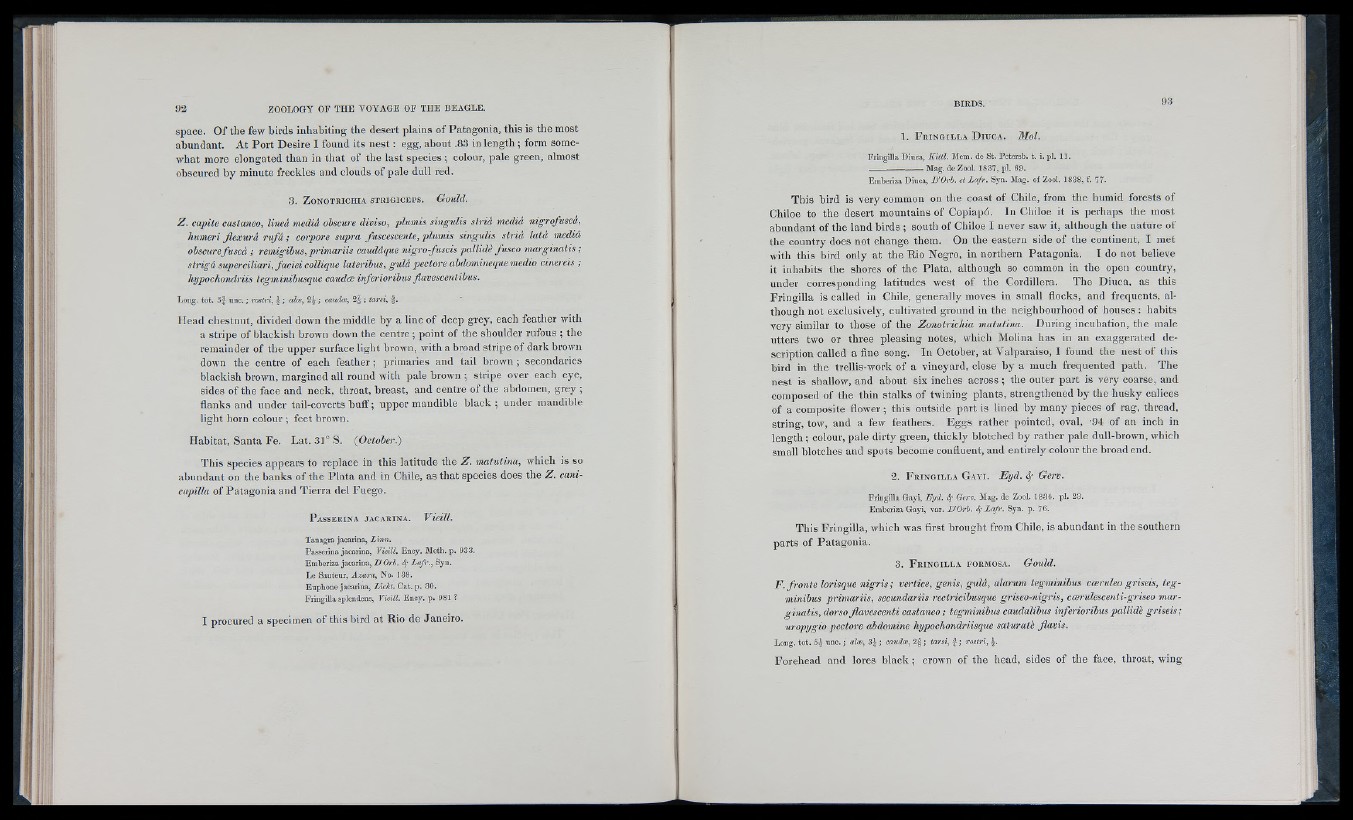
space. Of the few birds inhabiting the desert plains of Patagonia, this is the most
abundant. At Port Desire I found its nest : egg, about ,83 in length ; form somewhat
more elongated than in that of the last species ; colour, pale green, almost
obscured by minute freckles and clouds of pale dull red.
3 . Z o n o t r i c h i a s t r i g i c e p s . G o u l d .
Z. capite castaneo, lineâ mediâ obscure diviso, plumis singulis stria media nigrofusca,
humeri flexurà rufâ ; corpore supra fuscescente, plumis singulis striâ latâ mediâ
obscure fuscâ ; remigibus, primariis caudâque nigro-fuscis pallidè fusco marginatis ;
strigâ superciliari, faciei collique lateribus, gulâ pectore abdomineque medio ciñereis ;
hypochondriis tegminibusque caudæ inferioribus flavescentibus.
Long. tot. 5 f unc. ; rostri, ¿ ; aloe, 2^ ; caudæ, 2 | ; tarsi, | .
Head chestnut, divided down the middle by a line of deep grey, each feather with
a stripe of blackish brown down the centre ; point of the shoulder rufous ; the
remainder of the upper surface light brown, with a broad stripe of dark brown
down the centre of each feather ; primaries and tail brown ; secondaries
blackish brown, margined all round with pale brown ; stripe over each eye,
sides of the face and neck, throat, breast, and centre of the abdomen, grey ;
flanks and under tail-coverts buff ; upper mandible black ; under mandible
light horn colour ; feet brown.
Habitat, Santa Fe. Lat. 31° S. (October.)
This species appears to replace in this latitude the Z. matutina, which is so
abundant on the banks of the Plata and in Chile, as that species does the Z. canicapilla
of Patagonia and Tierra del Fuego.
P a s s e r in a j a c a r in a . Vieill.
Tanagra jacarina, Linn.
Passerina jacarina, Vieill. Ency. Meth. p. 933.
Emberiza jacarina, D ’Orb. Sf Lafr., Syn.
Le Sauteur, Á zara, No. 138.
Euphone jacarina, Licht. Cat. p. 30.
Fringilla splendens, Vieill. Ency. p. 981 ?
I procured a specimen of this bird at Rio de Janeiro.
1. F r i n g i l l a D i u c a . 3Iol.
Fringilla Diuca, Kittl. Mem. de St. Petersb. t. i. pl. 11.
--------— Mag. de Zool. 1837, pl. 69.
Emberiza Diuca, D'Orh. et Lafr. Syn. Mag. of Zool. 1838, f. 77.
This bird is very common on the coast of Ciiiie, from the humid forests of
Chiloe to the desert mountains of Copiapó. In Cliiloe it is perhaps the most
abundant of the land birds ; south of Chiloe I never saw it, although the nature of
the country does not change them. On the eastern side of the continent, I met
with this bird only at the Rio Negro, in northern Patagonia. 1 do not believe
it inhabits the shores of the Plata, although so common in the open country,
under corresponding latitudes west of the Cordillera. The Diuca, as this
Fringilla is called in Chile, generally moves in small flocks, and frequents, although
not exclusively, cultivated ground in the neighbourhood of houses : liahits
very similar to those of the Zonotrichia matutina. During incubation, tlie male
utters two or three pleasing notes, which Molina has in an exaggerated description
called a fine song. In October, at Valparaiso, I found the nest of this
bird in the trellis-work of a vineyard, close by a much frequented path. The
nest is shallow, and about six inches across ; the outer part is very coarse, and
composed of the thin stalks of twining plants, strengthened by the husky calices
of a composite flower ; this outside part is lined by many pieces of rag, thread,
string, tow, and a few feathers. Eggs rather pointed, oval, -94 of an inch in
length ; colour, pale dirty green, thickly blotched by rather pale dull-brown, whicli
small blotches and spots become confluent, and entirely colour the broad end.
2 . F r i n g i l l a G a y i. Eyd. ^ Gerv.
Fringilla Gayi, E yd . 4' Gorv. Mag. de Zool. 1834. pl. 23.
Emberiza Gayi, var. D ’Orh. S f Lafr. Syn. p. 76.
This Fringilla, which was first brought from Chile, is abundant in the southern
parts of Patagonia.
3 . F r i n g i l l a f o r m o s a . Gould.
V. fronte lorisque nigris; vei'tice, genis, gulâ, alarum tegminihiis cæruleo griseis, ieg-
minibus primariis, secundariis rectricihusque griseo-nigris, cærulescenti-griseo marginatis,
dorso fiavescenti castaneo ; tegminibus caudalibus inferioribus pallidè griseis ;
ui'opygio pectore abdomine hypochondriisque saturalè fiavis.
Long. tot. 54 nnc. ; aloe, 3^ ; cauAoe, 2 | ; tarsi, f ; rostri,
Forehead and lores black ; crown of the bead, sides of tbe face, throat, wing